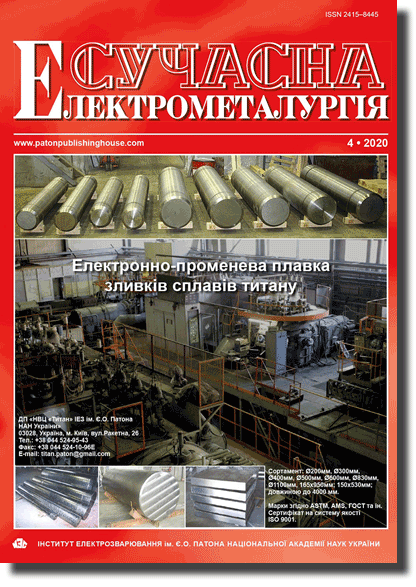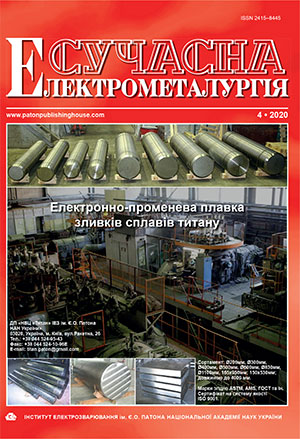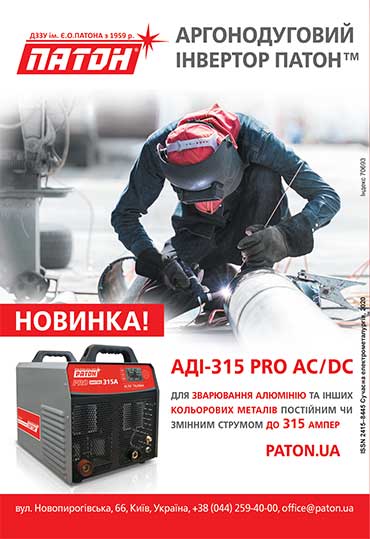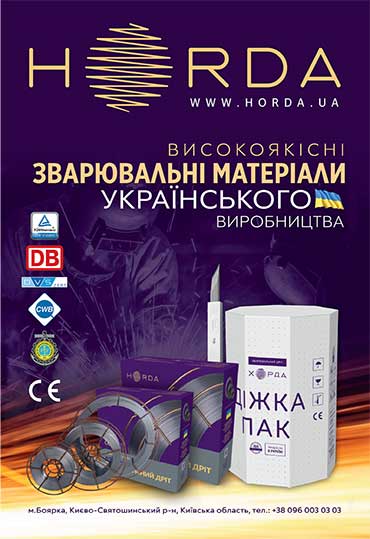| 2020 №04 (01) |
DOI of Article 10.37434/sem2020.04.02 |
2020 №04 (03) |
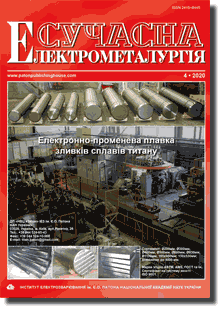
"Suchasna Elektrometallurgiya" (Electrometallurgy Today), 2020, #4, 7-15 pages
Structure and properties of structural sparsely-doped titanium-based alloys produced by EBM
S.V. Akhonin, V.Yu. Bilous, V.O. Berezos, I.K. Petrichenko, R.V. Selin, A.Yu. Severin, O.M. Pikulin
E.O. Paton Electric Welding Institute of the NAS of Ukraine. 11 Kazymyr Malevych Str., 03150, Kyiv, Ukraine. E-mail: office@paton.kiev.ua
Abstract
Work on melting ingots of pseudo-β-alloy Ti–2.8Al–5.1Mo–4.9Fe and pseudo-α-alloy Ti–1.5Fe–0.4O was performed. Electron beam unit UE208M with a cold-hearth and portioned feed of liquid metal was used to produce ingots of a round cross-section of 110 mm diameter, which were deformed to 6 mm thickness. The structures of the rolled plates were studied. Metal structure of sparsely-doped alloy of Ti–2.8Al–5.1Mo–4.9Fe system consisted from equiaxed polyhedral β-grains, with dispersed particles of α-phase located in their volume, here the amount of β-phase can vary within 50…82 %, while the structure of pseudo-α-alloy Ti–1.5Fe–0.4O consisted of platelike α-phase, with β-phase located in the spaces between the plates. Dispersed particles of titanium-iron intermetallics of less than 1 μm size were observed in the structure of both the alloys. Precipitation of iron-based titanium intermetallics can be the cause for low values of ductility and brittle fracture of metal of sparsely-doped pseudo-β-alloy Ti–2.8Al–5.1Mo–4.9Fe. Strength of alloy Ti–1.5Fe–0.4O is as-rolled condition was on the level of 730 MPa. Strength of sparsely-doped alloy of Ti–2.8Al– 5.1Mo–4.9Fe system in as-rolled condition was on the level of 1015 MPa, while the values of impact toughness KCV and relative elongation were equal to 3…4 J/cm2 and 1.9 %, respectively. Ref. 17, Tabl. 4, Fig. 9.
Keywords: sparsely-doped titanium alloys, electron beam melting; ingot; chemical composition; deformation; semifinished products; structure; mechanical properties
Received 29.09.2020
References
1. (2013) Titanium Metal: Market Outlook to 2018. 6th Ed., Roskill Information Services Ltd, USA.2. Nochovnaya, N.A., Panin, P.V., Alekseev, E.B., Bokov, K.A. (2014) Sparcely-alloyed titanium alloys for laminated metal- polymer materials. Trudy VIAM, 11 [in Russian]. https://doi.org/10.18577/2307-6046-2014-0-11-2-2
3. Iliin, A.A., Kolachev, B.A., Polkin, I.S. (2009) Titanium alloys. Composition, structure, properties. Moscow, VILS-MATI [in Russian].
4. Khorev, A.I., Belov, S.P., Glazunov, S.G. (1992) Metals science of titanium and its alloys. Moscow, Metallurgiya [in Russian].
5. Niinomi, M. (2011) Recent trends in titanium research and development in Japan. In: Proc. 12th World Conf. on Titanium, I, 30-37.
6. Bania, P.J. (1993) Beta titanium alloys and their role in the titanium industry, In: Beta Titanium Alloys in the 90`s, TMS Publications, Warrendale, PA, 3-14.
7. Weiss, I., Semiatin, S.L. (1998) Thermomechanical processing of beta titanium alloys on overview. Mat. Sci. Eng. A243, 46-65. https://doi.org/10.1016/S0921-5093(97)00783-1
8. Akhonin, S.V., Markovskii, P.E., Berezos, V.A. et al. (2018) Producing of high-strength titanium alloy Ti-1,5Al-6,8Mo- 4,5Fe by EBM method. Sovrem. Elektrometallurgiya, 1, 9-16 [in Russian]. https://doi.org/10.15407/sem2018.01.02
9. Osipenko, A.P. (2015) Development of technology for producing raw materials for titanium alloys from substandard sponge titanium. Eastern-European J. of Enterprise Technologies, 4(5), 28-32 [in Russian]. https://doi.org/10.15587/1729-4061.2015.47789
10. Below, S.P., Brun, M.Ya., Glazunov, S.G. et al. (1992) Metals science of titanium and its alloys. Ed. by S.G. Glazunov, B.A. Kolachev. Moscow, Metallurgiya [in Russian].
11. Nochovnaya, N.A., Antashev, V.G. (2007) Titanium alloys of «LOW-COST» series and possibilities of their application. In: Proc. of Int. Conf. on Ti-2007 in CIS. Kiev, IMP, 191-192.
12. Paton, B.E., Trigub, N.P., Akhonin, S.V., Zhuk, G.V. (2006) Electron beam melting of titanium. Kiev, Naukova Dumka [in Russian].
13. Akhonin, S.V., Pikulin, A.N., Berezos, V.A. et al. (2017) Electron beam melting of new high-strength titanium alloy T120. Sovrem. Elektrometallurgiya, 1, 15-21 [in Russian]. https://doi.org/10.15407/sem2017.01.03
14. Akhonin, S.V., Pikulin, A.N., Berezos, V.A. et al. (2019) Laboratory electron beam unit UE-208M. Ibid., 3, 15-22 [in Russian]. https://doi.org/10.15407/sem2019.03.03 https://doi.org/10.15407/sem2019.03.03
15. Moiseev, V.N. (2001) Mechanical Engineering: Encyclopedia. Vol. 2-3: Nonferrous metals and alloys. Ed. by I.N. Fridlyander. Chapter 2: Titanium and titanium alloys. Moscow, Mashinostroenie, 271-353 [in Russian].
16. Akhonin, S.V., Belous, V.Yu., Selin, R.V. et al. (2018) Electron beam welding and heat treatment of welded joints of high-strength pseudo-β titanium alloy VT19. The Paton Welding J., 7, 10-14. https://doi.org/10.15407/tpwj2018.07.02
17. Antashev, V.G., Nochovnaya, N.A., Shiryaev, A.A., Izotova, A.Yu. (2011) Perspectives of development of new titanium alloys. Vestnik MGTU, Ser. Mashinostroenie, 60-67 [in Russian].
Advertising in this issue:
The cost of subscription/purchase order journals or individual articles
| Journal/Currency | Annual Set | 1 issue printed |
1 issue |
one article |
| TPWJ/USD | 384 $ | 32 $ | 26 $ | 13 $ |
| TPWJ/EUR | 348 € | 29 € | 24 € | 12 € |
| TPWJ/UAH | 7200 UAH | 600 UAH | 600 UAH | 280 UAH |
| AS/UAH | 1800 UAH | 300 UAH | 300 UAH | 150 UAH |
| AS/USD | 192 $ | 32 $ | 26 $ | 13 $ |
| AS/EUR | 180 € | 30 € | 25 € | 12 € |
| SEM/UAH | 1200 UAH | 300 UAH | 300 UAH | 150 UAH |
| SEM/USD | 128 $ | 32 $ | 26 $ | 13 $ |
| SEM/EUR | 120 € | 30 € | 25 € | 12 € |
| TDNK/UAH | 1200 UAH | 300 UAH | 300 UAH | 150 UAH |
| TDNK/USD | 128 $ | 32 $ | 26 $ | 13 $ |
| TDNK/EUR | 120 € | 30 € | 25 € | 15 € |
AS = «Automatic Welding» - 6 issues per year;
TPWJ = «PATON WELDING JOURNAL» - 12 issues per year;
SEM = «Electrometallurgy Today» - 4 issues per year;
TDNK = «Technical Diagnostics and Non-Destructive Testing» - 4 issues per year.





